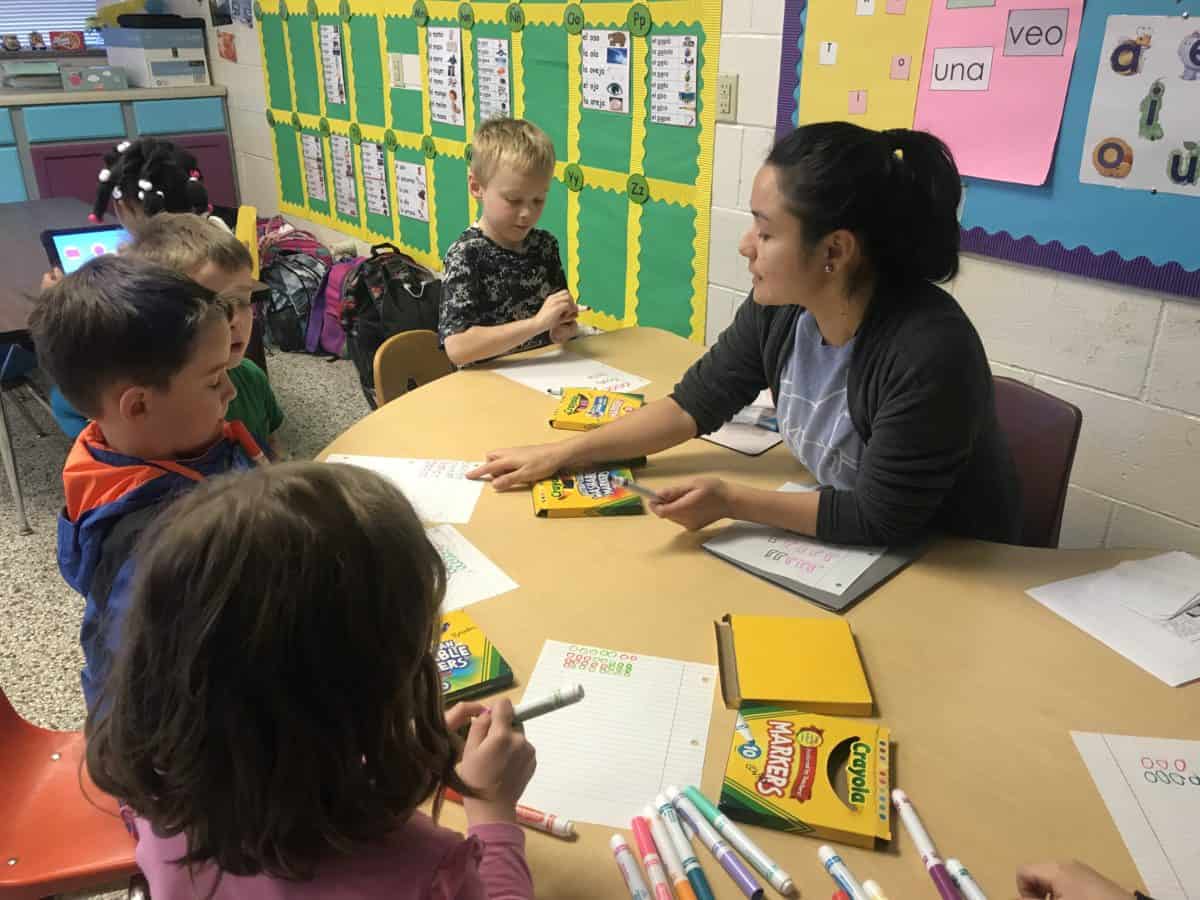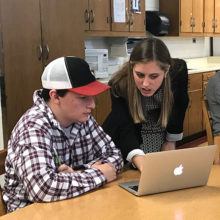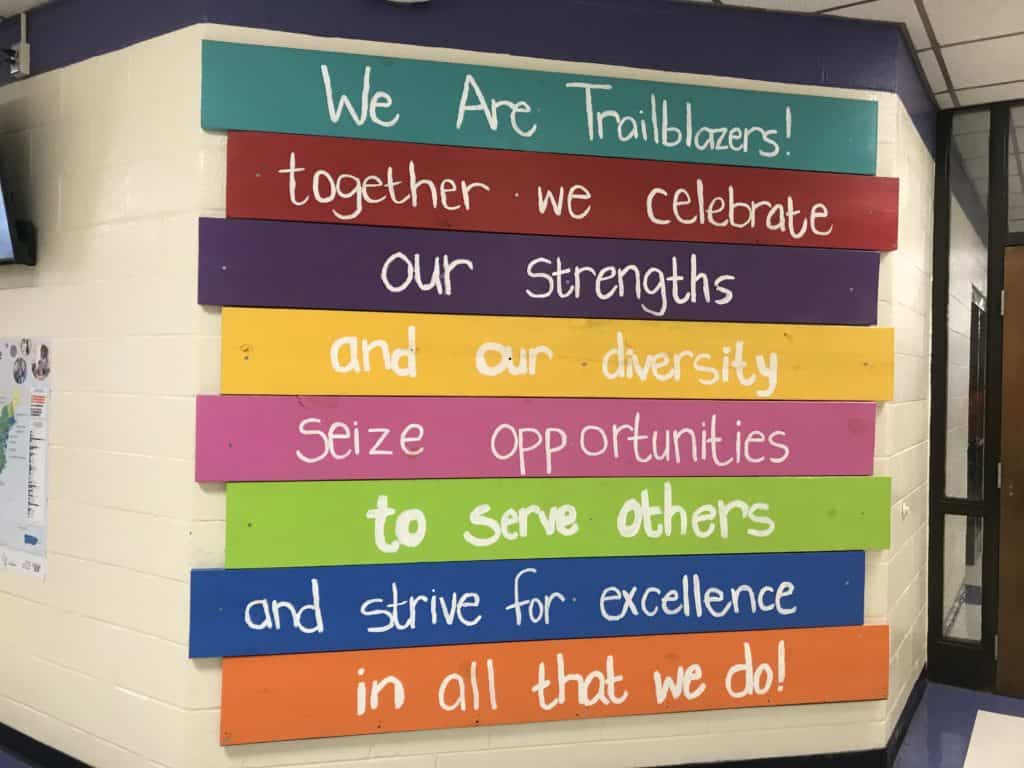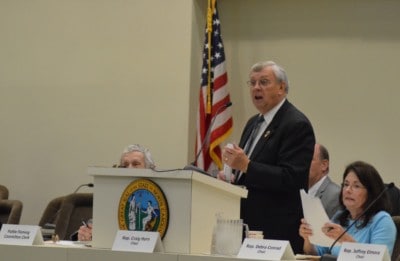

According to the consent order signed by Judge David Lee, a plan of action for the provision of the constitutional Leandro rights must ensure a system of education that includes “a finance system that provides adequate, equitable, and predictable funding to school districts and, importantly, adequate resources to address the needs of all North Carolina schools and students, especially at-risk-students as defined by the Leandro decisions.”
This is the second piece in a week-long series that will examine each of the components of the Leandro consent order through the lens of schools and communities in North Carolina. Follow along with the entire series here.
“¿Cómo estás?” I heard as I entered a kindergarten class at Martin Millennium Academy. “Bien,” I responded, as the class greeted me in Spanish.
Founded in 2014, Martin Millennium Academy is a dual-immersion school serving around 700 students in kindergarten through eighth grade in Tarboro. The school is a school of choice, meaning parents choose to send their kids there. There is usually a waiting list, principal Kelly Anne Mudd said, and they usually only take new students for the immersion program in kindergarten.
Roughly half the students participate in the immersion program. Starting in kindergarten, students take 90% of their classes in Spanish and 10% in English. By the time they get to third grade, they have 90 minutes of Spanish and 90 minutes of English. Students continue to take classes in Spanish and English throughout the rest of their time there.
Martin Millennium also participates in Opportunity Culture, an initiative of Public Impact that allows high-performing teachers to take on leadership and coaching roles in the school through a model called Multi-Classroom Leadership. Edgecombe County Public Schools introduced Opportunity Culture in the 2017-18 school year and rolled it out district-wide in 2019-20.
Dual immersion and Opportunity Culture are great resources for students, but for principals and district leaders, figuring out how to pay for them can be a challenge.
“We have about 75 scholars in fourth grade. The way the current allotment formula is [the Department of Public Instruction] says, oh, that’s a beautiful three classes of 25. And they would be right if we were all traditional or all immersion,” Mudd explained.
“The way it works out is I end up having a traditional class of about 20, a traditional class of another 20 … a class of 16 immersion and another class of 16 immersion. I can’t mix immersion with traditional or traditional with immersion to make a nice three classes, but I’m only allotted 3 [classroom teacher] positions.”
Mudd is referring to the classroom teacher allotments that dictate how many teachers each district can hire. Based on the number of students in each district, the state funds a certain number of classroom teacher positions. For example, for every 23 students in grades seven and eight, the state funds one classroom teacher position. You can find the teacher allotment formula for every grade on page 58 here.
So how does Mudd meet her students’ needs without another classroom teacher?
“We’ve had to create the most ridiculous master schedule,” Mudd said, “where some traditional students go to an immersion teacher to learn science and social studies and English while the immersion kids leave their Spanish teacher and go learn from a traditional English teacher. And it’s just this constant traveling.”
Luckily, Mudd said, Martin Millennium Academy is a Title I school, which means they get additional federal funding. Right now, 80% of the school’s Title I funding goes towards human capital, particularly paying for the Opportunity Culture Multi-Classroom Leaders.
“If we were a non-Title I school, there would be no option but to figure out this crazy schedule,” Mudd said.
“Even though the schedule is working, I think that both traditional students and immersion students are not 100% getting what they need,” she added.
Mudd’s experience is not unique. Every day across North Carolina, principals and district leaders are trying to figure out how to pay for the things their kids need using a combination of state, federal, and, in some counties, local funding.
Mudd’s story illustrates the importance of how North Carolina funds its schools. The formulas, rules, and regulations around K-12 funding all impact how schools are able to serve their kids and whether or not the state can meet its obligation set out in the Leandro lawsuit to provide all kids the opportunity for a sound basic education.
In 2017, the parties in the Leandro case agreed that an independent consultant should be chosen to make recommendations on how the state can provide a sound basic education to all kids and selected the consulting group WestEd to conduct the study. The report was released publicly in December 2019, and it identified eight critical needs, one of which is adequate, equitable, and aligned finance and resource allocation.
In January 2020, the judge in the case signed a consent order requiring the parties to create short-, middle-, and long-term plans for how the state can implement the recommendations in the WestEd report. The order states that any action plan must include:
“A finance system that provides adequate, equitable, and predictable funding to school districts and, importantly, adequate resources to address the needs of all North Carolina schools and students, especially at-risk-students as defined by the Leandro decisions.”
For the last few years, North Carolina legislators have been considering changing the way the state funds K-12 education. In 2016, the General Assembly Program Evaluation Division published a report that found significant issues with the current system. Based on this report, the General Assembly passed a law in 2017 creating a Joint Legislative Task Force on Education Finance Reform tasked with studying various funding models and developing a new model.
The task force met roughly once a month from November 2017 to April 2018 but did not make any recommendations. The 2019 legislative budget included a provision to extend the task force through March 31, 2020, but after Gov. Cooper’s budget veto, the task force is now expired.
Types of funding models
Student-based allocation (also called weighted student funding): Districts receive a certain amount of money per student, and they decide what to do with that money. Students with higher needs receive more funding, which is what makes it a weighted system.
Resource-based allocation: Districts receive money for a certain amount of inputs (i.e. teachers, teachers assistants, etc.) based on the number of students in the district.
Categorical or program allocation: The state allocates a set amount of money for specific programs.
Hold harmless or reimbursement systems: Districts receive the same amount or more money than they received the previous year.
Hybrid: A system that combines two or more of these funding mechanisms.
North Carolina’s current funding system
North Carolina’s funding system is a resource-based allocation model. According to Education Commission of the States, North Carolina is one of only 11 states to use some form of resource-based allocation. Most states use a student-based allocation formula, also called a foundational formula.
The majority of North Carolina’s funding of K-12 education is through its funding of teachers, which is done through a position allotment. Many superintendents and school finance officers like the current system because of the classroom teacher allotments. These allotments allow the districts to hire whatever teacher they would like to hire, and the state then pays that teacher’s salary and benefits.
“The position allotments are extremely important to every school system but particularly so in small, rural school systems,” said Rob Jackson, superintendent of Edenton-Chowan Public Schools. “That’s probably the best piece of our current funding system because … when we recruit teachers or sit down to interview teachers, what we’re looking for is the very best teacher we can find because our children deserve that.”
Yet just because smaller districts have the ability to hire veteran teachers with higher salaries does not mean that those teachers want to teach in those districts. The 2016 Program Evaluation Division report found that the classroom teacher allotment actually creates funding inequities between poorer districts and wealthier ones because veteran teachers who command higher salaries are more likely to teach in wealthier districts. Because the districts are funded based on the salaries of the actual teachers they hire, the poorer districts with a higher share of beginning teachers end up receiving less funding from the state than the better-resourced districts.
“Over time, this position allotment chronically underfunds [poorer] districts,” Eric Houck, associate professor at UNC’s School of Education, said. “It creates false hope for poorer [districts] that they are going to be able to hire the best candidate that they can when the labor market for those jobs in those districts is curtailed. It perpetuates the myth that there’s a $60,000 or $80,000 teacher that wants to come work in a rural, far-flung, low-wealth district. That’s the exception, not the rule.”
On top of the classroom teacher allotments, districts receive a number of other allotments. These allotments are split between position allotments, like classroom teachers, and dollar allotments, where districts receive an amount of money for a specific purpose. Additional position allotments include allotments for assistant principals, principals, and instructional support. Dollar allotments include money for teaching assistants, textbooks, and classroom materials and supplies, among other things.
Districts also receive funding for various student characteristics, such as limited English proficiency, children with special needs, and something known as disadvantaged student supplemental funding. Small districts and those deemed low-wealth by the state receive supplemental funding as well under North Carolina’s current system.
In 2016, the General Assembly’s Program Evaluation Division reported there are 37 different allotments, each with their own rules and regulations. This makes for a complicated system that some critique for its lack of transparency.
“It makes it very difficult to see how much money the state in actual dollars is pushing down to districts because it’s hidden in salary figures or student characteristics,” Houck said. “It allows the state to obfuscate their responsibility to districts and keeps us from having a common language for discussing equitable distribution of resources.”
In addition to the complexity, many feel the system does not give districts enough flexibility to do what they think is best for their kids.
“Lack of flexibility in how to spend state funds was [Chief Finance Officer’s] most frequently cited obstacle in aligning funding with student needs at the local level,” the WestEd report states.
As it currently stands, North Carolina’s funding formula places much of the decision making power of how to spend money on education at the state level. Through the position allotments, districts have set rules on how many teachers they must hire based on how many students they have. Because position allotments are the bulk of state funding flowing to districts, districts are left with a small pot of money that they have discretion over how to spend.
“North Carolina essentially provides districts with something akin to a stack of gift cards, each of which holds limited or no value outside of a narrow purpose that is determined by state officials,” a 2019 John Locke Foundation report describes.
North Carolina is currently experimenting with giving schools greater flexibility over how to spend their money. Low-performing schools can apply to become a restart school, which means they are granted flexibility over things like how many of their teachers have to be licensed and how they use their funding.
Edgecombe County has several restart schools, and those principals and district leaders are learning how to best use their resources.
“Our principal at Coker-Wimberly had a resignation in a third grade position,” Edgecombe County Public Schools Director of Innovation Erin Swanson explained. “He just decided not to fill that. And he knows from our bookkeeper exactly the dollar value of that teacher … So now he actually has $50,000, and he can say, ‘I’m going to pay the sub this much,’ and he’s got a teacher who he can now pay a stipend to be an Extended Impact Teacher and take on some of that workload of that sub, and he can afford a [teaching assistant] to be in that class.”
This type of budget maneuvering would be much harder, if not impossible, in a non-restart school, Mudd said.
Swanson recently visited Rowan-Salisbury Schools, which has restart status for all its schools, and she left impressed with how they are leveraging their funds to see the needs of their schools.
“I think the more flexibility the better,” Swanson said. “If the autonomy really fell to the principal and their leadership team to make those decisions, then I think that would open the doors for more innovation.”
What comes next?
The WestEd report looked at three components of North Carolina’s funding system: 1) the equitable distribution of funding across school districts; 2) the alignment of funding to students needs; and 3) the adequacy of education funding. The report found that the current distribution of funding is both inequitable and inadequate to meet student needs.
The report makes several recommendations to reform the funding formula and increase the level of investment in K-12 education. For the funding system, it recommends keeping the position allotments “due to widespread popularity” but phasing in a weighted student funding formula for all allotments besides the position allotments.
In terms of adequacy of funding, it recommends substantially increasing the amount of funding for K-12 education by first identifying a small number of high-impact investments followed by a sustained increase in funding overall.
Based on the recommendations in the report, the parties are now creating action plans for the judge to review. As policymakers move forward, there are several things to consider.
First, there needs to be a process for involving superintendents and school finance officers in the decisions. Throughout my interviews with superintendents, they stressed the importance of having a voice in the process as decisions are made over the coming year.
“I just hope that as the decision makers really dig into this work,” Superintendent Jackson said, “they involve finance officers, superintendents, principals, the folks who are working with the finances on a daily basis so there’s not some unintended consequences.”
Involving these stakeholders in the process will not only lend their expertise to solving these problems, but it will also make it much more politically feasible to make changes if they feel they are part of the process.
“If, as a result of the WestEd recommendations, there is a change to the school funding formula, it is my hope that superintendents will have a voice in the process,” said Greene County Superintendent Patrick Miller. “The superintendents understand school funding intimately and can work collaboratively with policymakers to strengthen the system while helping avoid any unintended consequences.”
Secondly, the state needs to decide how much flexibility will be granted to districts and schools and what guardrails, if any, are necessary. Several recommendations in the West Ed report would give districts greater decision making power over how to spend the money they receive, including removing transfer restrictions on some allotments and phasing in a weighted student funding formula for everything except the position allotments. If North Carolina moved to a fully weighted student funding formula, districts would have even greater flexibility in determining how best to spend the money.
The argument to give districts more flexibility stems from the age-old argument that those closest to the issues should be the ones making the decisions. Others, however, fear that removing restrictions on funding means there is no check to make sure districts are spending the money responsibly.
“I’m quite fearful of throwing the baby out with the bathwater,” Sen. Rick Horner, R-Johnston, said during an April 2018 finance reform task force meeting on weighted student funding formulas. “Because when you put that much flexibility on the local level, it really requires a total rethinking of the management teams at the local level, much beyond what we have now in place where our system pretty much dictates what you do, and you don’t have to be innovative to be a superintendent.”
Horner is not alone in this concern. If districts have more power to decide where to spend their money, Houck thinks the state would need to play a greater regulatory role.
“With fungible dollars I would expect there to also come accountability in a different way,” Houck said. “The state would have to take a firmer regulatory hand, and I think you’d have to have a much stronger link with higher education.”
That brings up a third consideration: capacity building for district and school leaders to implement a new funding model, especially if that model grants them greater decision making power.
“While I do believe it would be nice to have a change to a less cumbersome system, my concern would be let’s understand what the new system would be, pluses and minuses, and let’s make sure we have enough time to train superintendents and finance officers before we change,” Jackson said. “In a school year, we don’t have time to mess up.”
From his research on funding models in other states, Houck said states that have moved to weighted student funding formulas have challenges of capacity building.
“If you take a class of superintendents and school finance officers who have never had an extra dollar to spend and now give them money to spend … there would need to be training,” he said.
In states like Michigan, who have had weighted student funding formulas for some time now, Houck said he believes the systems work fairly well. However, it takes some adjustment, and training is necessary, he said.
Ann McColl, co-founder and president of The Innovation Project, emphasized the importance of capacity building in moving to a system where local leaders have more power.
“Site-based decision making in and of itself doesn’t matter,” she said. “The reason is some people do it well and some people don’t, so it ends up being a wash. If you are looking to make this change, what’s the capacity building that you need to do?”
Finally, any new funding system needs to be built not just with current needs in mind but also future needs. If North Carolina wants to increase teacher leadership roles, like Opportunity Culture, does the funding model allow for that staffing structure? If North Carolina wants to build community schools or dual immersion schools, how does the funding model support those? If schools and districts want to fundamentally reimagine what education looks like, as in the School of Innovation in Edgecombe County, does the funding model support or inhibit that? And as dual enrollment programs grow across the state, how does the funding model allow for greater collaboration between the K-12 and community college systems?
There are two ways to think about changing the funding formula, McColl said. One is to just say we are looking at the funding system and the big pieces that go into it. The other is “to be thinking about it in the context of realizing we want to do some things differently and seeing where the funding system is a barrier.”
Importantly, McColl stressed, there is no perfect system. Every funding system has its pros and cons. As policymakers think through these issues, they should think about what kind of education system they want in the future, who they want to be making the decisions around resources, and how the funding system either helps or hurts those goals.
Leandro resources
Everything you need to know about the Leandro litigation by Ann McColl
Sound Basic Education for All: An Action Plan for North Carolina (WestEd Report)
Executive Summary of WestEd’s Report
WestEd’s supporting reports:
- Statewide assessment system
- Statewide accountability system
- Cost adequacy, distribution, and alignment of funding
- Supporting student learning by mitigating student hunger
- High-poverty schools: Assessing needs and opportunities
- School success factors
- Attracting, preparing, supporting, and retaining educational leaders
- Educator supply, demand, and quality
- Developing and supporting teachers
- Best practices to recruit and retain well-prepared teachers
- Retaining and extending the reach of excellent educators
- How teaching and learning conditions affect teacher retention and school performance
Supplement to the Investment Overview and Sequenced Action Plan in the WestEd Report
Judge David Lee’s consent order
Draft priorities from the Governor’s Commission on Access to Sound Basic Education
- Finance and Resources Work Group
- Teacher Work Group
- Principal Work Group
- Early Childhood / “Whole Child” Work Group
- Assessment and Accountability Work Group
Editor’s note: Patrick Miller serves on EducationNC’s Board.










